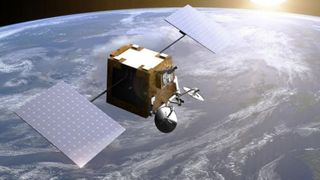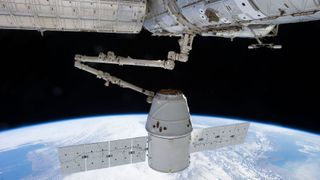Everything you need to know about SpaceX's Starlink and 'space internet'
Cheap, fast internet access from orbit

Elon Musk’s SpaceX is making a huge commitment to the internet. Not in the form of another one of its “whoop whoop yeah!” style webcasts (though it will do that, too), but by steadily launching up to 12,000 of SpaceX’s own satellites that could eventually bring fast Internet access to every human irrespective of where they are on the planet.
This is Starlink, and it’s happening.
At the time of writing, Starlink makes up a quarter of all active satellites, and that share is only increasing each month. The service has deployed over 1,000 satellites in order to provide internet access to its current subscribers and is continuing to expand so it can boost both coverage and performance.
What is Starlink?
Starlink is a plan by SpaceX to put 12,000 satellites into low Earth orbit (LEO) that offer high-speed, low-latency, cheap internet access to anyone anywhere on the planet. That’s the end-game. All you would need to use Starlink is a $200 pizza box-sized receiver. Each satellite will talk to four others using lasers as they constantly orbit Earth, together creating a web of Ku-band and Ka-band broadband connectivity as fast as the speed of light that surrounds the planet at all times, and for all locations.
In order to beam connectivity to the surface, a massive network of ground-based stations will also be necessary. So although 12,000 satellites sounds like a lot, it's only a fraction of the infrastructure that SpaceX will have to construct.
Starlink will happen in phases, but the ultimate goal is to have about 8,000 satellites orbiting just 500km above the planet, and the remaining 4,000 orbiting much higher up, at around 1,200km.

How many people are currently using Starlink?
According to a recent FCC filing, over 10,000 people have enrolled in the public beta test which launched last year. This number accounts for users across the US, Canada, and the UK.
Get daily insight, inspiration and deals in your inbox
Get the hottest deals available in your inbox plus news, reviews, opinion, analysis and more from the TechRadar team.
The filing’s objective is to have Starlink designated as an eligible telecommunications carrier. This would allow SpaceX to access millions in funding from the Rural Digital Opportunity and increase the reach of its coverage.

How good is Starlink’s internet?
In the same FCC filing where we are told about the number of users, we also learned some stats for the service. For a service that’s still only in beta, they aren’t half-bad.
- Users are achieving decent internet speeds, with download speeds of 100 Mbps (megabits per second) and upload speeds of 20 Mbps.
- Latency is at or below 31 milliseconds, based on 95% of measurements.
These will obviously be more favorable views of the company’s current capabilities, and a fair distance away from the 10 Gbps Starlink hopes to achieve, but they show that ‘space internet’ is definitely a viable option in the industry, and that’s only at one-twelfth of the planned satellites!

What is 'space internet'?
Space internet is simply satellite-powered Internet access. This is not a new thing. Telecommunications satellites mostly sit in a geostationary orbit thousands of miles above Earth's equator and follow the direction of Earth's rotation, so appearing to stay in one place to serve one region. Their distance from Earth means a lag of about a second or more.
However, actual internet access via existing satellites is severely limited; Iridium’s LEO network offers data speeds of 2.4 kbps, and though that’s soon going to jump to 512 kbps (thanks to several dedicated rocket launches by SpaceX, ironically), it’s expensive and designed to serve companies and governments that need critical links in remote areas of the world (think container ships and scientists in the Antarctic), not the mass market.
Starlink satellites will be 65 times closer to Earth than geostationary satellites, and could also offer speeds of 10Gbps, which is faster than fiber optic internet.

Why is SpaceX getting into ‘space internet’?
If SpaceX can offer speeds of 10 Gbps to every human on the planet, and undercut land-based networks, it could become a massive internet service provider. Add to that the fact that 50% of humans still have no internet access, and you start to see why SpaceX is so interested in making the most of its own rocket launch capabilities.
Though constructing Starlink could cost over US$10 billion, there’s evidence that SpaceX expects Starlink could earn it US$30 billion each year by 2025. Starlink’s success could therefore be pivotal for Elon Musk’s plans to go to Mars.

Is Starlink the only ‘space internet’ provider?
Far from it. The world of satellite broadband is hotting-up, and high-speed ‘space internet’ is increasingly looking like the future. Expensive, regionally-locked yet fast satellite broadband services are incoming, while OneWeb – supported by Intelsat, Virgin Qualcomm, SoftBank and Hughes Networks Systems – intends to launch 640 satellites across 21 launches to create global broadband by 2020.
It launched its first 12 satellites in February. There’s also Amazon, whose ‘Project Kuiper’ could see 3,236 satellites create a global broadband internet service after 2021.
SpaceX Starlink is hugely ambitious, but it won’t be alone.
Jamie is a freelance tech, travel and space journalist based in the UK. He’s been writing regularly for Techradar since it was launched in 2008 and also writes regularly for Forbes, The Telegraph, the South China Morning Post, Sky & Telescope and the Sky At Night magazine as well as other Future titles T3, Digital Camera World, All About Space and Space.com. He also edits two of his own websites, TravGear.com and WhenIsTheNextEclipse.com that reflect his obsession with travel gear and solar eclipse travel. He is the author of A Stargazing Program For Beginners (Springer, 2015),
Most Popular


